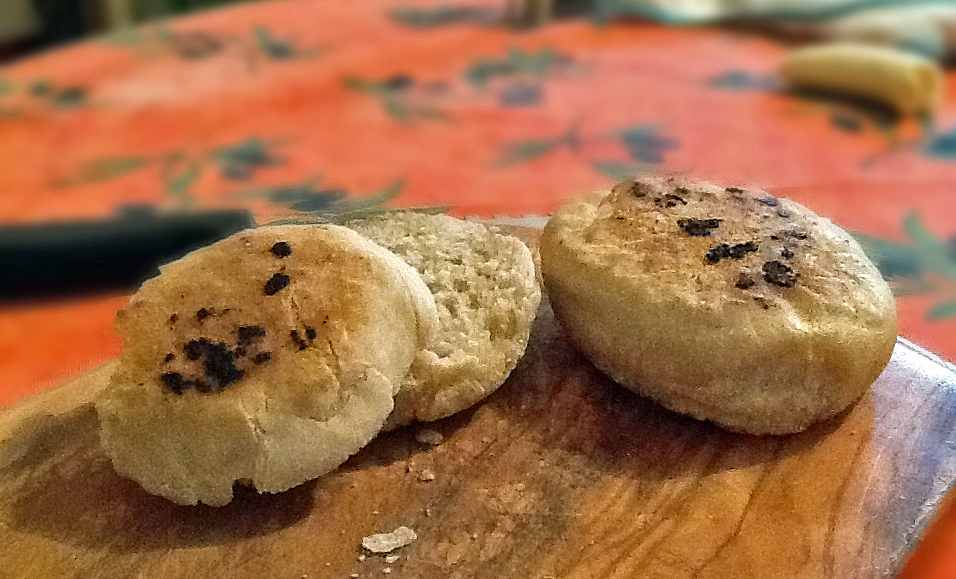Muffins, redux
Long, but well worth it (bear in mind a lot of it is waiting for the dough to rise, so actual active prep time is much less, around 30 mins maybe?).

Recipe type: Bread
Cuisine: English
Preparation time: Over a day
Cooking time: 14h
Total time: 14h30
Serves: 9 muffins
So… adventures in baking part the Nth. Muffins, again. This time using a recipe from Daniel Stevens’ The River Cottage Bread Handbook (an absolutely fabulous book that does a great job of demystifying bread-making and giving you tools for troubleshooting your bread–something that’s bound to happen when you get to one of the stages mentioned here…).
Things you’re going to need: those two videos here, one on kneading, and one on forming a round (you don’t need to mix the dough on the working surface like they do, at least I got on fine without that!). I used a lot of the techniques that were in the book, but I think those two cover about all you need to know.
The end result is pretty salty; but that’s probably me dumping 12g of salt by mistake, following a slight scales snafu…
A word of warning that US flours are (from what I’ve been told, I have no personal experience of this) much richer in proteins than European ones, so it’s highly possible the water amounts are off. I’d suggest you use the amount of water you normally use for making a white bread, plus 3%?
Another word of warning: it’s better to weigh here than do it by volume, because of the variable weight vs volume ratio of the flour (so I haven’t given volume equivalents).
- 500g bread flour (I used 300g T65 and 200g T55 flour, if you're in France)
- 310 mL cool water (not cold, just straight from the tap)
- 5g instant yeast
- 7-10g salt (to taste)
- A drizzle sunflower oil plus extra for coating mixing bowl
- Semolina for dusting
- The night before (12 hours ahead), prepare the sponge: mix the yeast, 250g of flour and all the water with stiff fingers until you get a rough dough. Cover and leave at room temperature.
- On the following morning, take the mixing bowl (you should have little bubbles in your dough), add the remaining flour, and the salt, and mix until you get a soft dough. Add the drizzle of oil: it should be soft, definitely not soggy (but not too dry either: if it falls apart when you pull on it, add oil).
- At this stage, turn on your oven to the lowest setting, wait a bit, and turn it off so it's warm inside (we're trying to get 25°C so the dough can rise. The catch is the yeast dies at 60°C or so, so you don't want it to warm. If you can touch the sides and it's warm, you're probably at the right temperature).
- Knead for 10 to 20 minutes, until you can form a "window" by stretching a piece of the dough: a piece of dough thin enough to see daylight through it. If the dough breaks or tears before you get to that point, you need to knead it again.
- Wash the mixing bowl and oil it. Form a round (see links), and put it in the mixing bowl. Cover and put in the oven (which is *off* at this stage) for the next two hours, or until doubled in size.
- When the dough is ready, tip it onto the working surface, and gently deflate it by pressing down on it. Separate it into 9 balls. Form each of them into rounds, then gently push down to flatten to 2cm or so.
- Proving: dust a baking tray with semolina, put the rounds on it (leave a lot of space between them, because they're going to double in size while proving), and put in your oven (which is still off, but still warm) for the next half-hour or so. You know your muffins are proved when they have doubled in size, and, if you gently squeeze them, the dough springs back to its shape.
- Heat up a heavy frying pan on low heat (I mean "low heat" here, I really do, because they burn very easily). Transfer the muffins to the frying pan in batches: cook for 1 minute then flip over, cook for 5 minutes on each side, and crank up the heat for the last bit of the cooking, to give the crust that golden, hardened finish (beware though, the line between "golden" and "charred" is thin. Really thin.